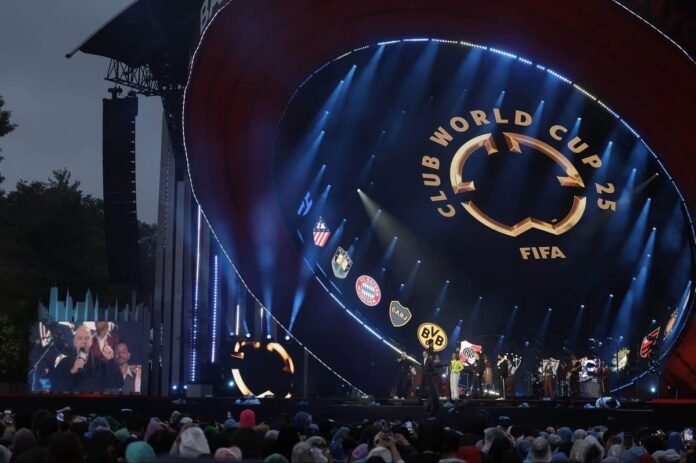The controversial Club World Cup is coming closer to fruition.
FIFA on Saturday night chose the annual, star-studded Global Citizen Festival in Central Park to announce the 12 cities and venues that will host the inaugural tournament, with president Gianni Infantino, who did not seem unhappy at sharing a stage with Hugh Jackman, talking excitedly of fans recreating the festival’s “buzz” between June 15 and July 13 next year.
The update by FIFA — including that the final will be played at New Jersey’s MetLife Stadium, which will also host the final of the men’s World Cup almost exactly one year later — was certainly welcome, given how little has been shared about the tournament. It signalled to the world, and those potentially investing in the competition, that FIFA is still forging ahead with the 32-team competition, despite speculation to the contrary.
Coming to the USA in 2025 🇺🇸#TakeItToTheWorld | #FIFACWC pic.twitter.com/ocAOgy87Fl
— FIFA Club World Cup (@FIFACWC) September 28, 2024
But there are significant steps that must still be taken over the next 259 days.
There remains no media rights partner for the tournament, sponsorship agreements are pending and, because of this, the monetary value for participating clubs remains a giant question mark.
Infantino last week went as far as calling an emergency meeting with broadcasters in hopes of persuading them of the merits of the tournament, as pressures behind the scenes mount for FIFA to make good on its hopes for billions in TV revenues to help fund the prize money for competing clubs. The FIFA head promised global broadcasters in the video call that venues would be announced before the end of the month, a promise he successfully kept.
It seems FIFA is, in some ways, leveraging the success of their men’s World Cup to draw interest for the Club World Cup. On Saturday, FIFA also announced it had teamed up with Global Citizen for the first-ever World Cup final half-time show in 2026 – a foreign concept in global football, but beloved tradition in American football.
Gianni Infantino (left), Hugh Jackman and Gayle King at the Global Citizen Festival in New York (Noam Galai/Getty Images for Global Citizen)
Next year’s Club World Cup is also important for FIFA to course-correct the U.S. market after last summer’s Copa America, especially in the run-up to the World Cup in 2026. Though the South American tournament is run by CONMEBOL, many critics questioned if the U.S. was ready for a World Cup after security failings and less-than-stellar crowds, even for matches featuring the U.S. men’s national team. Though a World Cup is likely to draw sellouts simply by virtue of being the world’s most popular sporting event, a Club World Cup, like the South American tournament, will be a much harder sell for American fans.
The Club World Cup has already faced serious opposition, notably around player welfare. There have been growing concerns that players could go on strike over the number of games they are being asked to play in, with the Club World Cup adding to an already-congested global match calendar, and in the middle of a summer transfer window.
Some have pointed to the recent season-ending injury for Spanish footballer Rodri as the heartbreaking example of what can happen if this level of congestion is not taken seriously. The Manchester City midfielder, who was the first to say players were “close” to going on strike, suffered the injury just one week after expressing his concerns about workload. It’s worth noting that City face an 11-month-long campaign if they were to reach the final of the Club World Cup.
Javier Tebas, the head of Spain’s La Liga, recently said at a press conference that he would welcome a strike if it wiped the Club World Cup off the agenda but the controversy isn’t just brewing in the court of public opinion. Three of the biggest players’ unions in Europe also recently filed legal action against FIFA over the saturated calendar, calling the new tournament a “tipping point.”
The English Professional Footballers Association (PFA), the Italian players’ union (AIC) and their French counterparts (UNFP), say the rights of players are being violated under EU laws after FIFA added the Club World Cup to the end of the 2024-25 season. FIFPro, the global footballers union, is supporting the case, with the ultimate goal of challenging the legality of FIFA’s ability to “unilaterally” set the International Match Calendar.
Despite the pushback, it seems FIFA is dead set on pushing ahead with the men’s Club World Cup, although mystery still surrounds the women’s event. No details have been announced for that competition, which FIFA had originally said would be staged in January 2026 and feature 16 teams. Even the host country remains unknown at this stage.
It was largely expected the men’s competition would overwhelmingly be an East Coast affair, with at least one match set for Seattle because Major League Soccer’s Seattle Sounders are in the competition. Because the CONCACAF Gold Cup is taking place in the U.S. simultaneously, FIFA and CONCACAF had come to a previous agreement to host matches on opposite sides of the country as to avoid any overlap.
The Club World Cup is proposed to be held every four years, with some describing it as Infantino’s prized possession. It will act as a primer for the expanded men’s World Cup in the U.S. held that following summer, with five World Cup 2026 venues, including MetLife, also slated to host Club World Cup games next year.
Now, as the world awaits sponsorship and media rights deals for the men’s Club World Cup, and any information at all about the women’s event, the next expected update will be in December, when the tournament’s draw will take place.
Future details for the draw, FIFA said on Saturday, will be released “in due course” — but the clock is ticking.
(Top photo: Adam Hunger – FIFA/FIFA via Getty Images)
Read the full article here


